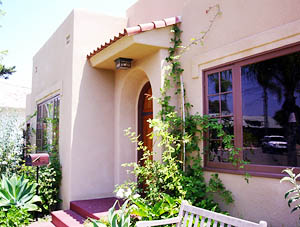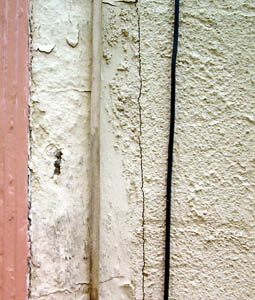|
Let's Talk Stucco
By Beth Montes
 Example of correct stucco on this 1926 Craftsman Bungalow.
|
 Example of poor restucco job. Stucco on this 1922 Spanish Revival is completely flush with window trim on left, different textures have been applied throughout the years.
|
Those of us who own older homes or are thinking of purchasing one know there are myriad issues to consider; is the plumbing going to need work, is the electrical wiring still knob and tube, are there cracks in the foundation, are the windows rotting out? There is one issue, however, which is often over-looked, though very important to the historical look and integrity of some of these homes - exterior stucco.
A large number of older San Diego homes have exterior stucco finishes. The terms "stucco" and "plaster" are used interchangeably. The exterior walls of a home are the primary architectural element on its public face and should be treated as such. Unfortunately, all too often, the stucco has been altered in such a manner as to damage or completely eliminate this large portion of the structure's historic fabric.
A member of the City's Historical Resources Board, SOHO President, and preservation architect David Marshall, is concerned that San Diego's collection of stucco homes is quickly losing its integrity. He warns that, if a dwelling's stucco is original, complete replacement is rarely necessary and should be avoided. The idea is to maintain what is there. Sometimes homeowners think that large cracks or missing areas of stucco mean the whole exterior needs replacement. Many times a stucco contractor or company will encourage complete replacement since it is an easy and profitable course of action. Mr. Marshall says the only reason to consider total replacement is in the case of significant loss or delamination, where stucco layers are separating from themselves or from the wall. The vast majority of stucco defects can be dealt with by using spot repairs.
When undertaking stucco repairs, the best method is to deal with each damaged area individually by repairing cracks and adding matching stucco to missing portions, then painting the repaired area to match existing. In cases where the stucco was never painted and has a natural tint from the original materials, great care should be taken to try to match the color by using replacement materials as close to original as possible. If this method will not work, the next best alternative would be to color coat the stucco, ensuring the new stucco finish matches the historic finish in color and texture. The last choice would be total stucco replacement.
Exterior stucco is applied using a three-part process. On early 20th century homes, a base layer is typically applied to wire mesh attached to layers of black paper nailed or stapled to wooden lath. This coat, called the scratch coat, is approximately 1/2-inch thick and is heavily scored. The second coat, called the brown coat, is about 1/4-inch thick and is scored, though not as heavily as the scratch coat. The final coat is called the finish, or color, coat and is approximately 1/8-inch thick. The complete stucco finish is commonly no more than 7/8-inch thick. The color coat may get its tint naturally from the ingredients used to create the stucco, may be tinted by adding natural or man-made pigments, or may be painted.
Homes previously re-stuccoed are likely to have had the newer stucco applied directly over the original. In these cases, the stucco finish is likely much thicker than the desired 7/8-inch. Thick stucco causes a change in relationship between wooden trim around windows and doors and the exterior wall. At times, the stucco is so thick that the trim looks like it is flush with the wall or recessed instead of standing out from it. When complete stucco replacement is the only viable option, the best course of action is to completely remove it, taking the walls back to the studs, and starting over with new wire mesh and three-part stucco finish.
Most of the large stucco companies around town have perfected only two types of stucco finishes, fine sand float and heavy sand float. Neither finish is appropriate for older homes. These types of finishes are found on nearly every stucco house built since the 1960's and look thick, rough, and sometimes have a swirling pattern. It is more difficult for these companies to match existing finishes because it takes time and skill to mimic the older techniques. If a contractor tries to talk you into total replacement or states he cannot duplicate your existing finish, call someone else. Smaller companies and independent contractors are more likely to be willing to work with you. Your contractor should make mock-up examples for you and keep making them until the proper look is achieved. If possible, keep several samples of original material for future reference.
Homeowners should keep in mind that stucco is not considered a waterproof barrier. When the stucco gets wet, black paper underneath it repels the water, keeping it out of the home's interior. Natural ingredients in the stucco allow it to dry out after exposure to water. When replacing or color coating existing stucco, David Marshall strongly advises property owners to stay away from newer, acrylic stucco finishes. Water can work its way beneath the acrylic layer via cracks around windows and doors. Since the acrylic material does not breathe, the underlying paper never completely dries out, leading to mildew in the walls and on interior finishes.
The National Park Service has printed a brief entitled The Preservation and Repair of Historic Stucco, (nps.gov/history/hps/tps/briefs/brief22.htm). Owners of historic, or potentially historic, sites should consult this brief and the City's Historical Resources Board prior to undertaking any major stucco repair or replacement.
On a final note, Bruce Coons, SOHO's Executive Director, reminds owners of wood-sided homes that it is NEVER appropriate to cover the original wooden fabric with a stucco finish. Now if we could only do something about those vinyl window salesmen.
Photos by Sandé Lollis
|
MORE FROM THIS ISSUE
Adding to the Controversy
A Salute to Our Volunteers
Announcing San Diego's First Modernism Weekend
San Diego Modernism Weekend
Julius Shulman
Vintage Trailer Show Rolls In
SOHO Volunteers Needed for Modernism Weekend
Most Endangered List of Historic Resources
Preservation Revolving Fund
People In Preservation Award Winners
An Evening with People In Preservation
Cross-Border Preservation Updates
Irving Gill in Oceanside
From Seismic Event to Spanish Style
Time is Not on our Side
The San Diego Old House Fair In Review
Annual Call For Board of Director Nominations
Rancho Guajome Celebrates 150 Years
Governor Appoints Dr. Susan Hector
Highway 101 Museum
Let's Talk Stucco
Thank You
Wish List
SOHO Congratulates the San Diego Historical Society
Whaley House Docents & Volunteers
The Verna House to be Renovated
SOHO Speakers Bureau
Volunteer Appreciation Party
Annual Meeting
Strength in Numbers
DOWNLOAD full magazine as pdf (4.2mb)
|





